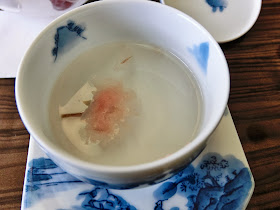You are so lucky. At this posting, you can see so rare photos.
Most of foreign people in the world, would not have ever seen
those photos.
(Actually, we also haven't ever seen the stuffs in our life)
I will write about ceremony of Yuinou on this posting.
We Japanese people do a formal ceremony, called "Yuinou no gi"
before we get married.
This tradition has many meanings.
First of all, this ceremony has the meaning of swearing the
engagemento in the public. And after this ceremony, each
family of the bride and groom becomes closer.
And second, the bride and groom exchange some gifts
each other.
Some decades ago, the bride used to invited the groom to her
house and did the ceremony. But nowadays, traditional styled
Japanese restaurant is used for the ceremony.
At this ceremony, some gifts are given from the groom to the bride.
The wife of the owner of Japanese restaurant is called
"Okamisann" She explained well about the meaning of the
gifts.
The groom needs to give a lot of money for the bride.
That is called "Yuinou kin" Kin means "money".
The gift on your right is Surume. It's a dried squid.
This dried food can be preserved for a long time.
This gift is given so that the bride and the groom can
make their living without missing a meal.
The gift on your left is Kobu. Kobu is a kelp.
In Japanese, we say Yoro"kobu" when you are happy.
So, a kelp has the meaning of lucky food.
The stuff on your right which looks like strings is called
Tomoshiraga. "Tomo" means "together". "Shiraga" means
"white hair". This gift is given so that the bride and groom
can live together until they get old.
This is "Katsuo bushi". It's a dried bonito.
"Katsu" has the meaning of "win" in Japanese.
So, this is lucky food in Japanese traditional culture.
This triadition is based on the idea the man work in the society.
We drank Sake, Japanese alchohol at the ceremony.
And the photos below are dishes we had after the ceremony.
Each dish is sophisticated...
The last photo is Sakura yu. They preserve the Sakura with salt
in the spring. This is also lucky food in Japanese traditional culture.
Well, this Japanese restaurant invited "Dame Elizabeth Taylor",
famous actress about 20 years ago. I saw the photo of then.
As I show you above, this Yuinou has a long history.
On wikipedia, the origin of Yuinou seems to go back until
4 or 5 century.
Well, that's about it, today.
I'm sure these are quite rare photos. Maybe this blog has not
been known at all. I don't know how much my activity of
introducing Japanese culture is valuable.
I just hope I dedicate to those who are interested in Japanese
culture. I hope I play a role as a brighe between other cultures.
Thanks for reading.
https://www.facebook.com/SeeMyJapan












I actully do feel lucky to be able to read this blog. I did not know at all about this tradition, and now I have spent quite some time on the web researching, but true enough: not many good pictures about this ceremony.
ReplyDeleteYou are a very gifted photographer - your pictures are well focused and detailed.
As always, I am amazed by how neat and beautiful all things are - not only the gifts, but also the dishes - it trully looks like work of art.
I hope you had a lovely day at the ceremony and it has left a beautiful memory for both of your families.
Shantal ForSD
ReplyDeleteI think Japanese people do
not know about the history of our tradition well.
Old tradition tend to disappear
unless people try to keep it.
The purpose of this blog is
to deepen my understanding of
Japanese culture.
I hope I would be able to explain
about our culture much better
when I have a chance to talk about it in the future.
Thank you for explaining about this ceremony and the significance of all the different elements of this ceremony. Our friends have just done Yuinou ceremony for their daughter. So interesting to have it explained and with beautiful photos. I really enjoyed your blog.
ReplyDeleteAnonymous
ReplyDeleteYou're welcome.
I hope you keep reading
my blog.^^